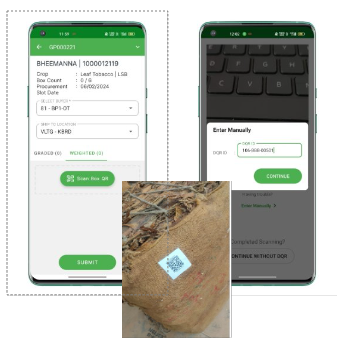Contact: +91 99725 24322 |
Menu
Menu
Quick summary: Maximize ROI in agribusiness procurement with digital tools like blockchain and data analytics. Discover how these technologies improve efficiency, traceability, and decision-making.

You’re running an agribusiness and trying to procure everything you need — seeds, fertilizers, machinery, and more. But with outdated methods, you’re stuck navigating a maze of paperwork, manual processes, and communication delays. Sound familiar? This is the reality for many in the agribusiness sector who rely on traditional procurement methods. In an industry as complex and fast-moving as agriculture, efficiency is the name of the game and maximizing ROI in agribusiness procurement is crucial.
Managing costs, building strong supplier relationships, and staying on top of demand cycles can make or break profitability. Yet, outdated procurement systems often lead to wasted time, hidden costs, and missed opportunities. To thrive, agribusinesses need to streamline how they source and manage supplies, making procurement efficiency more critical than ever. Fortunately, digital tools are transforming how agribusinesses handle procurement. By automating processes, enhancing data visibility, and fostering real-time collaboration, these solutions offer a chance to boost efficiency and, ultimately, improve return on investment (ROI). Let’s explore how embracing digital tools is reshaping procurement management for a smarter, more profitable future in agribusiness.
Key Takeaways
When we talk about return on investment (ROI) in agribusiness procurement, we’re essentially looking at the value you get compared to what you put in. Think of it as a way to measure whether all the money, time, and effort spent on procurement are truly paying off. For agribusinesses, ROI isn’t just about saving money—it’s about making every dollar, resource, and effort count so you can maximize profits, improve operations, and grow your business sustainably.
However, getting the most out of procurement is easier said than done. Let’s break down some of the hurdles agribusinesses face:
By addressing these challenges and improving procurement efficiency, agribusinesses can boost ROI, lower costs, and build a more resilient and competitive operation. Effective procurement management in agriculture involves strategically sourcing raw materials, equipment, and services needed for agricultural operations while ensuring sustainability, cost-efficiency, and compliance with regulatory standards. This is where digital tools come in, offering innovative ways to streamline processes and make data-driven decisions that drive growth.
Agriculture procurement faces numerous challenges, including fluctuating market prices, unreliable supply chains, and the need for sustainable sourcing practices.
Traditional procurement often involves a lot of manual work. From filling out forms by hand to managing mountains of paperwork, it’s a time-consuming and tedious process. Mistakes are common, like missing entries or errors in calculations, which can lead to delays or costly corrections. Not only does this slow things down, but it also takes time away from other important tasks that could be helping your agribusiness grow.
Another major challenge is limited access to accurate data. When procurement records are scattered across spreadsheets, emails, and physical documents, it becomes hard to see the bigger picture. Without clear data, how do you know which suppliers are the most reliable, or if you’re overpaying for certain materials? This lack of transparency makes it difficult to control costs and make smart, timely decisions. In today’s fast-paced market, it’s like trying to navigate without a map.
Inefficient procurement often leads to wasted resources. When you don’t have streamlined processes, you’re more likely to overorder supplies, experience delays, or even run out of essential stock when you need it most. This drives up costs unnecessarily and impacts your overall profit margins. High operational costs mean you’re spending more than you need to, often with little to show for it. This can weaken your competitiveness and slow your business growth.
Imagine being able to manage your entire procurement process with just a few clicks instead of dealing with stacks of papers and endless emails. That’s what digital tools offer. These tools range from specialized procurement platforms that streamline purchasing orders, to data analytics software that helps you track spending and supplier performance. Then there’s cutting-edge technology like blockchain traceability systems, which can provide a complete, unchangeable record of every step in your supply chain. By using these tools, agribusinesses can move from outdated, manual methods to efficient and organized digital systems.

Picture this: no more filling out endless forms or manually managing purchase orders. Automated procurement systems handle repetitive tasks for you, making processes faster and far less error-prone. These systems streamline ordering, inventory, and payment processes, cutting down on mistakes that could cost you money and time. With automation, your team can focus on higher-value activities, ultimately saving you both time and labor costs while increasing overall efficiency.
Data is a game-changer. With data-driven analytics, you can gather real-time insights on your procurement activities. This means you know exactly what you’re spending, where you might be wasting money, and how supplier performance stacks up. Analytics can even predict future trends and demand, helping you make smarter buying decisions and avoid overstocking or shortages. When you base your decisions on data instead of gut feelings, you maximize your ROI through informed strategies and reduced procurement risks.
Transparency is a huge deal in modern agribusiness. Blockchain-based traceability platforms offer a digital record of every step your products go through, from sourcing to delivery. This reduces the risk of fraud, ensures compliance with regulations, and builds trust with customers by guaranteeing product authenticity. By using these platforms, you can trace any issues that arise back to their origin point and act quickly, minimizing financial losses and reputation damage.
TraceX tracks VST’s tobacco journey from farm to factory, ensuring a seamless, transparent, and sustainable procurement process. By leveraging blockchain technology, TraceX provides real-time traceability, allowing all stakeholders—including farmers, suppliers, and factories—to access critical information throughout the supply chain. This approach not only ensures ethical sourcing and sustainability but also enhances farmer management by offering them better visibility and data-driven insights. By using this digital tool, VST can maintain high-quality standards, reduce inefficiencies, and strengthen relationships with stakeholders while promoting sustainable agricultural practices. This case study demonstrates how blockchain can transform agricultural procurement by driving transparency and accountability.
Your suppliers are crucial to your success. SRM tools help you build stronger relationships with them. These tools provide insights into supplier performance, enabling you to work more closely with top-performing partners, negotiate better deals, and resolve issues before they escalate. When your relationships are strong, you often get better pricing, more reliable service, and higher-quality products—all of which lead to improved ROI.
Procurement costs can quickly add up if they aren’t closely managed. Cost management software gives you the ability to track spending across different categories and identify areas where you can cut back. Whether it’s finding cheaper sourcing alternatives, negotiating better deals, or reducing waste, this software helps you optimize every dollar you spend. By controlling costs more effectively, you improve your bottom line without compromising on quality or efficiency.
1. Assessing Needs and Setting Goals: Identifying ROI-Driven Objectives
Before diving into digital procurement tools, it’s essential to understand what your business truly needs. Start by asking, What do we want to achieve? Are you looking to reduce costs, improve supplier relationships, or speed up your procurement process? Defining clear, measurable goals will give you a roadmap and help you measure success down the line. For example, if your goal is cost reduction, your objective could be to streamline vendor selection and reduce manual processes, ensuring you get better deals.
2. Choosing the Right Tools: Tips for Selecting Tools that Align with Business Goals
Not all procurement tools are created equal. When choosing the right software, make sure it aligns with your company’s specific needs and objectives. Some tools focus on supplier management, while others offer advanced analytics for smarter decision-making. Ask yourself: Does this tool solve a real pain point? Consider factors like ease of use, scalability, and integration capabilities with your existing systems. It’s important to pick a tool that not only fits now but also grows with your business in the future.
3. Integrating with Existing Systems: Ensuring Seamless Adoption to Maximize Benefits
Once you’ve selected your tools, integration is key. It’s essential that your new procurement software works smoothly with other business systems, such as your ERP (Enterprise Resource Planning) or accounting tools. The smoother the integration, the quicker your team can start benefiting from the tool’s full potential. During this phase, focus on training and onboarding, ensuring everyone knows how to use the tool effectively. If adoption is seamless, you’ll see improvements in efficiency, compliance, and overall productivity – all leading to higher ROI.
By assessing needs, choosing the right tool, and ensuring smooth integration, you can unlock the full potential of digital procurement tools and maximize ROI for your business.
TraceX offers a comprehensive suite of procurement features designed to enhance efficiency, transparency, and sustainability in agricultural supply chains.
1. Farmer Verification: TraceX ensures transparency and compliance through robust farmer identification processes, validating their identity and land ownership. This step helps prevent fraud and ensures that only legitimate farmers are engaged in procurement.
2. Procurement Tokens: Based on quality parameters, procurement tokens are issued after acceptance of produce. These tokens, embedded with QR codes, provide detailed information about the procurement activity, ensuring traceability and real-time updates.

3. Bluetooth-Enabled Weighing Scales: To ensure fair transactions, TraceX integrates Bluetooth-enabled scales that streamline the weighing process. This automation enhances accuracy and efficiency, reducing the risk of manual errors in data entry.
4. Dynamic QR Mapping: Utilizing dynamic QR codes, TraceX enhances traceability by allowing real-time updates on product information such as origin, production date, and quality parameters. This feature enables stakeholders to access up-to-date product histories throughout the supply chain.
5. Market Price/Procurement Price Tracking: This feature allows organizations to monitor market fluctuations and set appropriate procurement prices based on real-time data. This ensures fair pricing for both buyers and suppliers.
6. Custom Sales Receipts and SMS Notifications: TraceX automates communication by generating customized sales receipts and sending SMS notifications to farmers about their transactions. This fosters transparency and keeps farmers informed in real-time.
7. Grading and Pricing Lists: The system facilitates grading of procured stock based on quality parameters, enabling fair pricing aligned with market standards.
By leveraging these features, TraceX empowers agribusinesses to streamline procurement processes, enhance communication with farmers, ensure compliance with safety standards, and ultimately build a more resilient and equitable agricultural supply chain.
Digital tools are transforming procurement in agribusiness, providing greater visibility, efficiency, and traceability in the supply chain. By leveraging technology like blockchain and data analytics, businesses can streamline processes, reduce waste, and enhance decision-making. The key to maximizing ROI lies in selecting the right tools that align with business goals, integrating them seamlessly into existing systems, and continuously measuring their impact. As agribusinesses continue to evolve, adopting digital procurement solutions will be crucial for staying competitive and sustainable in the long term.
Digital procurement tools help agribusinesses improve supply chain transparency, reduce fraud, lower operational costs, and enhance data-driven decision-making. They also streamline vendor management and ensure compliance with sustainability standards.
Blockchain ensures end-to-end traceability in the supply chain, offering transparency and reducing the risk of fraud. It helps verify the origin and quality of products, allowing businesses to meet regulatory requirements and gain trust with consumers.
The ROI of digital procurement tools can be measured through cost savings, improved efficiency, faster decision-making, and enhanced supplier relationships. Businesses can track key performance indicators (KPIs) like reduced procurement cycle time, cost reductions, and increased supply chain transparency to assess the impact of the tools.
